Norman Rockwell's
Vision of America
by Bob Brooke
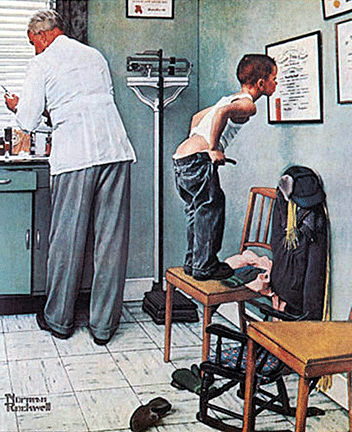 Does
your doctor's office have a picture of a young boy, standing on a
chair reading a certificate while the doctor prepares a needle? That’s a
print of a painting by Norman Rockwell. Even if you've never heard of
him , there's a really good chance you've seen one of paintings on the
cover of an old Saturday Evening Post. Does
your doctor's office have a picture of a young boy, standing on a
chair reading a certificate while the doctor prepares a needle? That’s a
print of a painting by Norman Rockwell. Even if you've never heard of
him , there's a really good chance you've seen one of paintings on the
cover of an old Saturday Evening Post.
Picture a nation of patriotic citizens unencumbered by want or fear,
free to speak their minds and worship as they chose. In a simple room,
generations gather for a bountiful Thanksgiving feast. In a dimly lit
bedroom, a mother and father tuck their child safely into bed. At a town
meeting, a man stands tall and proud among his neighbors. In a crowd,
every head is bent in fervent prayer. This is Norman Rockwell’s America
as depicted in most likely his most famous series, "The Four Freedoms."
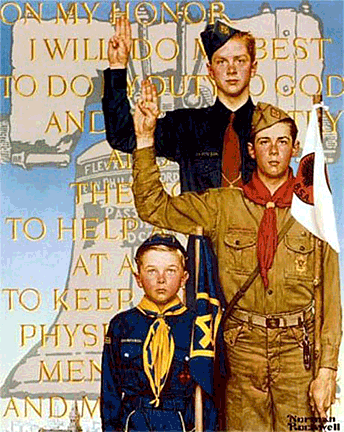 His
annual contributions for the Boy Scouts' calendars between 1925
and 1976 were only slightly overshadowed by the “Four Seasons"
illustrations for Brown & Bigelow that were published for 17 years
beginning in 1947 and reproduced in various styles and sizes since 1964 His
annual contributions for the Boy Scouts' calendars between 1925
and 1976 were only slightly overshadowed by the “Four Seasons"
illustrations for Brown & Bigelow that were published for 17 years
beginning in 1947 and reproduced in various styles and sizes since 1964
Rockwell once said, “Without thinking too much about it in specific
terms, I was showing the America I knew and observed to others who might
not have noticed.” What's unmistakable, however, is that Rockwell
tapped into the nostalgia of a people for a time that was kinder and
simpler. His ability to create visual stories that expressed the wants
of a nation helped to clarify and, in a sense, create that nation’s
vision.
His prolific career spanned the days of horse-drawn carriages to the
momentous leap that landed mankind on the moon. While history was in the
making all around him, Rockwell chose to fill his canvases with the
small details and nuances of ordinary people in everyday life.
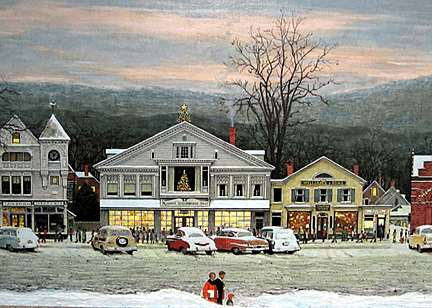 Taken together, his many paintings capture something much more
elusive and transcendent — the essence of the American spirit. “I paint
life as I would like it to be,” Rockwell once said. Taken together, his many paintings capture something much more
elusive and transcendent — the essence of the American spirit. “I paint
life as I would like it to be,” Rockwell once said.
Mythical, idealistic, innocent, his paintings evoke a longing for a time
and place that existed only in the rarefied realm of his rich
imagination and in the hopes and aspirations of the nation. According to
filmmaker Steven Spielberg, “Rockwell painted the American dream —
better than anyone.”
In 1910, at the age of 16, he left high school to study art at The
National Academy of Design.
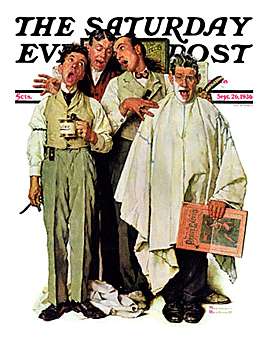 Rockwell
considered The Saturday Evening Post to be the “greatest show window in
America.” Over the next 47 years, another 321 Rockwell paintings would
appear on its covers. Rockwell
considered The Saturday Evening Post to be the “greatest show window in
America.” Over the next 47 years, another 321 Rockwell paintings would
appear on its covers.
The 1930s and 1940s proved to be the most fruitful period for Norman
Rockwell.
His success came from his appreciation for everyday American scenes, the
warmth of small-town life in particular. Often he treated what he
depicted with a simple charm and sense of humor as in "Billboard Painter,"
appearing on the Post on February 9, 1935.
His "Sharp Harmony," depicting a barber and three patrons enjoying
an a cappella song, appeared on the cover the Post on September 26,
1936.
Rockwell moved his family to Arlington, Vermont, in 1939 where his work
began to reflect small-town life.
Still, Rockwell didn't completely ignore the issues of the day. In 1943,
inspired by President Franklin D. Roosevelt’s speech to Congress, in
which he described four principles for universal rights: "Freedom from
Want," "Freedom of Worship," "Freedom from Fear," and "Freedom of Speech,"
he created one of his masterpieces, "The Four Freedoms."

He painted them for The Saturday Evening Post, and they proved very
popular. He completed the series in seven months, losing 15 pounds in
the process. The United States Department of the Treasury later promoted
war bonds by exhibiting the originals of the "Four Freedoms" in 16 cities.
The works toured the country in an exhibition that was jointly sponsored
by the Post and the U.S. Treasury Department and, through the sale of
war bonds, raised more than $130 million for the war effort. Rockwell
himself considered "Freedom of Speech" to be the best of the four.
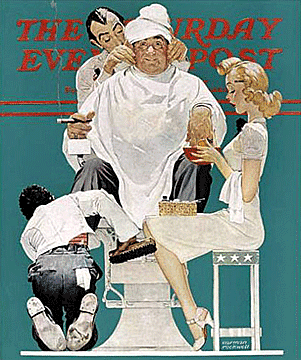 Although
the "Four Freedoms" series was a great success, 1943 also brought Rockwell
an enormous loss. A fire destroyed his Arlington studio as well as
numerous paintings and his collection of historical costumes and props. Although
the "Four Freedoms" series was a great success, 1943 also brought Rockwell
an enormous loss. A fire destroyed his Arlington studio as well as
numerous paintings and his collection of historical costumes and props.
What makes Rockwell’s work so effective is that he appears to have
shared with millions of Americans a set of assumptions about life in the
United States. He blended his illustration skills with a wealth of
careful observation to bring these assumptions to life as in this cover,
"Full Treatment," published on May 18,1940. While the ideas for his
Post covers originated with Rockwell himself, none were ever
executed
without the prior approval of the magazine's editorial staff—a staff
concerned with the tastes and interests of its readers.
Starting with the issue dated June 27, 1942, and the Rockwell cover
"Willie Gillis in a Blackout," the Post changed the layout formula of its
cover, giving Rockwell a good deal more flexibility. Also important is
the fact that Ken Stuart, who was appointed art editor in 1944, decided
that the cover should present, week by week, a cumulative and almost
documentary portrait of the changing face of the nation.
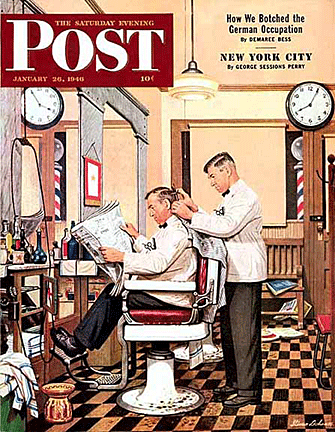 In
his later work, Rockwell shifts toward naturalism, blending the values
of America's recent past with the realities of a present that could no
longer be ignored. Since millions of Americans were presented with the
problem of making a similar adjustment in their own lives, they were
immediately able to identify with this changed mood in Rockwell's art as
in the Thanksgiving Post cover from November 27,1943. In
his later work, Rockwell shifts toward naturalism, blending the values
of America's recent past with the realities of a present that could no
longer be ignored. Since millions of Americans were presented with the
problem of making a similar adjustment in their own lives, they were
immediately able to identify with this changed mood in Rockwell's art as
in the Thanksgiving Post cover from November 27,1943.
Rockwell's new interests led him to the detailed documentation of
interiors and architectural settings. Rockwell's later covers and
illustrations give us an accurate record of this highly particularized
environment as in "The Barber Shop," published on January 26, 1946.
Often the paint on the walls is no longer fresh and there's garbage in
the streets. Rockwell packed his later work with unadulterated,
carefully observed information.
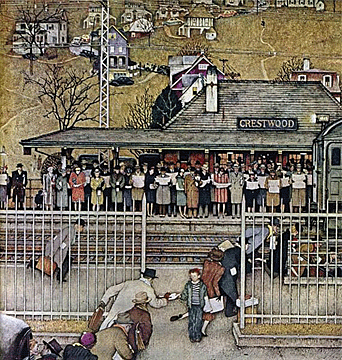 In
1946 Rockwell painted "The Commuters" for the cover of the Post a
suburban train station during the rush hour. In the foreground, crowding
onto a platform as a train pulls into the station or hurrying to reach
it, are the commuters. Faces are undifferentiated; clothes become
uniforms; everybody seems to be either reading or at least holding a
newspaper, presumably purchased from a boy selling newspapers at the
entrance. Beyond this mass of humanity lies a landscape of winter trees
and modest homes, power and telephone lines. If a viewer could walk among the
homes, he or she would probably find Red Cross stickers in the windows and
basketball hoops above garage doors. The focal point of the living room
would be a radio. It’s this panoramic view which makes this composition
so interesting. In
1946 Rockwell painted "The Commuters" for the cover of the Post a
suburban train station during the rush hour. In the foreground, crowding
onto a platform as a train pulls into the station or hurrying to reach
it, are the commuters. Faces are undifferentiated; clothes become
uniforms; everybody seems to be either reading or at least holding a
newspaper, presumably purchased from a boy selling newspapers at the
entrance. Beyond this mass of humanity lies a landscape of winter trees
and modest homes, power and telephone lines. If a viewer could walk among the
homes, he or she would probably find Red Cross stickers in the windows and
basketball hoops above garage doors. The focal point of the living room
would be a radio. It’s this panoramic view which makes this composition
so interesting.
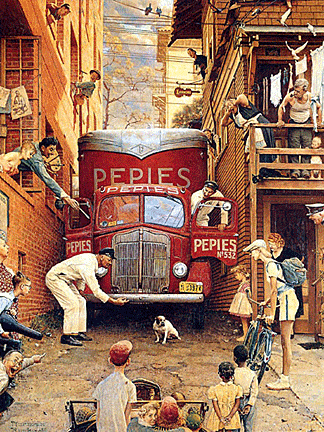 The
July 9, 1949 Post cover "Traffic Conditions" offers an example of
Rockwell’s view of urban America. Here a bulldog has brought a truck to
a halt in a narrow alleyway between two tenement buildings. The woman on
the couple on the porch is nearly hysterical, but her husband welcomes
the incident as a relief from boredom. In contrast, the younger people
in the street seem detached from their surroundings. The
July 9, 1949 Post cover "Traffic Conditions" offers an example of
Rockwell’s view of urban America. Here a bulldog has brought a truck to
a halt in a narrow alleyway between two tenement buildings. The woman on
the couple on the porch is nearly hysterical, but her husband welcomes
the incident as a relief from boredom. In contrast, the younger people
in the street seem detached from their surroundings.
Viewers can find another unidealized slice of American life in the November
5, 1949, cover, "The New Television Set." The theme is the new
technology of television which Rockwell represents by a set being
installed in the apartment of an elderly man. From his reaction, viewers can
see that it will bring a new dimension to his life. The fact that he
lives in an attic doesn't seem to matter.
The
April 4, 1953 painting "Walking to Church" is a good example of one
of Rockwell's detailed portraits of the American small town. The
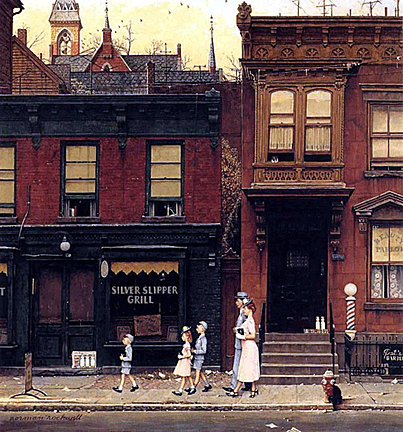 composition features the Silver Slipper Grill. It’s easy to imagine the
people who live in the shabby brownstone and the conversations that take
place on other days in the beauty parlor and the barber shop. The
architecture expresses a way of life and there’s garbage in the street.
Milk bottles and the Sunday papers wait on doorsteps. composition features the Silver Slipper Grill. It’s easy to imagine the
people who live in the shabby brownstone and the conversations that take
place on other days in the beauty parlor and the barber shop. The
architecture expresses a way of life and there’s garbage in the street.
Milk bottles and the Sunday papers wait on doorsteps.
"Saying Grace" was the most popular of all Rockwell's Post covers.
Painted for the November 24, 1951 Thanksgiving issue, it shows an old lady
and her grandson saying grace over their trays of food in the cafeteria
of a railway station, watched by a porter and other travelers. It’s the
couple’s adherence to the standards of home life in an alien environment
that serves as Rockwell’s vehicle for
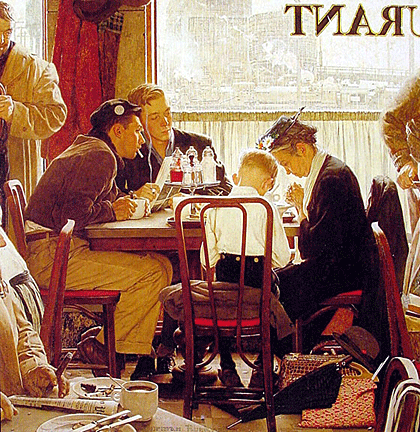 emotion,
and this relies entirely upon the authenticity that Rockwell brings to
his portrayal of the environment. Cigarette butts lie on the floor and a
cigar has been stubbed out on a saucer while a cup of coffee looks cold
and abandoned. A bleak natural light, filtered by clouds, rain, and
smoke, illuminates the scene. Of the nine people in this composition, only
the four at the table haven’t been cut off by the edges of the canvas, a
compositional device borrowed from photography. emotion,
and this relies entirely upon the authenticity that Rockwell brings to
his portrayal of the environment. Cigarette butts lie on the floor and a
cigar has been stubbed out on a saucer while a cup of coffee looks cold
and abandoned. A bleak natural light, filtered by clouds, rain, and
smoke, illuminates the scene. Of the nine people in this composition, only
the four at the table haven’t been cut off by the edges of the canvas, a
compositional device borrowed from photography.
Norman Rockwell aimed for the family audience. He tried to show the
ideal of family life. He showed Americans at holidays like Thanksgiving
and Christmas, in times of war, leading ordinary lives. He presents not
the event itself but its effect on home life. Typical of this is "Easter
Morning," a Post cover from May 16, 1959. The cover shows a father
slinking down in a chair while his wife and their three children strut
behind him on their way to church. His son casts a glancing eye his way
while his sisters and mother ignore him.
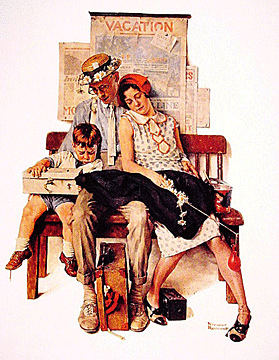 An
excellent 1930s cover, "The Vacation," shows a family united by
their common exhaustion. A poster behind them tells viewers that they’ve
been vacationing and the flowers in the wife’s right hand tell everyone
they had a good time. An
excellent 1930s cover, "The Vacation," shows a family united by
their common exhaustion. A poster behind them tells viewers that they’ve
been vacationing and the flowers in the wife’s right hand tell everyone
they had a good time.
In 1948 Rockwell presented the Truman/Dewey battle in a breakfast-table
scene in a painting called "Dewey vs. Truman," from October 30, 1948. Again,
the story is in the details—the toast waiting but forgotten in the
toaster, the baby propped up against a table leg.
Rockwell’s picture of family life is in many ways a capsule of his
picture of America. He takes it seriously but shows some humor. He
brings a realism to it which prevents him from over-idealizing his
subject matter. His scenes are a slice of life as in his cover, "The
Christmas Homecoming" from December 25, 1948.
Norman Rockwell approaches the subject of growing old in America with
sympathy. He showed dignity and respect, even when he painted older
people as a young man. "Family Saying Grace," from 1938.
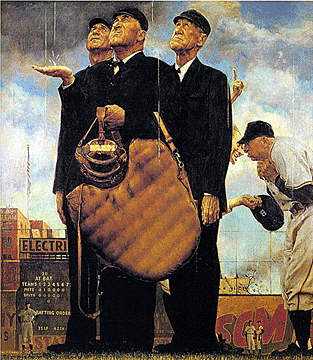 Rockwell
painted "The Dugout," appearing on September 4, 1948, as a tribute to
the Cubs and White Sox baseball teams, both of which finished last in
their leagues. The painting shows the disappointed look on the players’
faces and the jeering fans above them. Rockwell
painted "The Dugout," appearing on September 4, 1948, as a tribute to
the Cubs and White Sox baseball teams, both of which finished last in
their leagues. The painting shows the disappointed look on the players’
faces and the jeering fans above them.
Rockwell’s most notable baseball cover, "Game Called Because of Rain,"
appearing on the Post April 23, 1949, shows umpires about to call a game
as rain begins to fall from threatening skies.
President Jimmy Carter awarded Norman Rockwell the Presidential Medal of Freedom.
He died on November 8, 1978, of emphysema at age 84 in Stockbridge,
Massachusetts. First Lady Rosalynn Carter attended his funeral.
<
Back to More Special Features
Next Article > |
